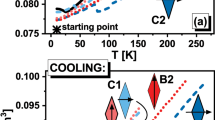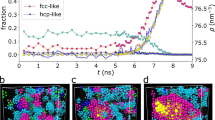Abstract
Many polymeric materials crystallize when cooled below their melting temperature. Although progress has been made in our understanding of the crystallization process through both experimental1 and theoretical2,3,4,5,6 efforts, these studies have focused mainly on the crystal nucleation and growth mechanism, where critical nuclei are formed from a metastable state during the first stages of crystallization, leading ultimately to the growth of crystal domains. Attention has also been given to the structure during the precrystallization (induction period7,8,9,10,11,12,13). A pretransition state occurring before crystallization has been characterized as an unstable phase separation initiated by density and orientational fluctuations. These fluctuations are caused by an increase in the average length of rigid trans segments along the polymer backbone during the induction period. These observations are consistent with the theory proposed in ref. 14 on the isotropic-to-nematic transition of polymer liquid crystals, that is, the parallel ordering of polymers is caused by an increase in chain rigidity. Here we use large-scale computer simulations to investigate melts of polymers in the early ordering stages (induction period) before crystallization. In the ordered domains we identify growing dense regions similar to smectic liquid crystals. Our simulations reveal a ‘coexistence period’ in the ordering before crystallization, where nucleation and growth mechanisms coexist with a phase-separation mechanism.
This is a preview of subscription content, access via your institution
Access options
Subscribe to this journal
Receive 12 print issues and online access
$259.00 per year
only $21.58 per issue
Buy this article
- Purchase on Springer Link
- Instant access to full article PDF
Prices may be subject to local taxes which are calculated during checkout




Similar content being viewed by others
References
Yau, S.-T. & Vekilov, P. G. Quasi-planar nucleus structure in apoferritin crystallization. Nature 406, 494–497 (2000).
Oxtoby, D. W. Phase transitions: Catching crystals at birth. Nature 406, 464–465 (2000).
Gee, R. H. & Fried, L. E. Ultrafast crystallization of polar polymer melts. J. Chem. Phys. 118, 3827–3834 (2003).
Olmsted, P. D., Poon, W. C. K., McLeish, T. C. B., Terrill, N. J. & Ryan, A. J. Spinodal-assisted crystallization in polymer melts. Phys. Rev. Lett. 81, 373–376 (1998).
ten Wolde, P. R. & Frenkel, D. Enhancement of protein crystal nucleation by critical density fluctuations. Science 277, 1975–1978 (1997).
Yamamoto, T. Molecular dynamics modeling of polymer crystallization from the melt. Polymer 45, 1357–1364 (2004).
Strobl, G. R. The Physics of Polymers (Springer, Berlin, 1996).
Cakmak, M., Teitge, A., Zachmann, H. G. & White, J. L. Online small-angle and wide-angle x-ray-scattering studies on melt-spinning poly(vinylidene fluoride) tape using synchrotron radiation. J. Polym. Sci. B 31, 371–381 (1993).
Terrill, N. J. et al. Density fluctuations: the nucleation event in isotactic polypropylene crystallization. Polymer 39, 2381–2385 (1998).
Kimura, T., Ezure, H., Tanaka, S. & Ito, E. In situ FTIR spectroscopic study on crystallization process of isotactic polystyrene. J. Polym. Sci. B 36, 1227–1233 (1998).
Heeley, E. L. et al. Early stages of crystallization in isotactic polypropylene. Macromolecules 36, 3656–3665 (2003).
Matsuba, G., Kaji, K., Kanaya, T. & Koji, N. Detailed analysis of the induction period of polymer crystallization by depolarized light scattering. Phys. Rev. E 65, 061801 (2003).
Kaji, K., Nishida, K., Matsuba, G., Kanaya, T. & Imai, M. Details of structure formation during the induction period of spinodal-type polymer crystallization. J. Macromol. Sci.-Phys. B 42, 709–715 (2003).
Shimada, T., Doi, M. & Okano, K. Concentration fluctuation of stiff polymers. III. Spinodal decomposition. J. Chem. Phys. 88, 7181–7186 (1988).
Muthukumar, M. & Welch, P. Modeling polymer crystallization from solutions. Polymer 41, 8833–8837 (2000).
Takeuchi, H. Structure formation during the crystallization induction period of a short-molecule system: A molecular dynamics study. J. Chem. Phys. 109, 5614–5621 (1998).
Hu, W., Frenkel, D. & Mathot, V. B. F. Intramolecular nucleation model for polymer crystallization. Macromolecules 36, 8178–8183 (2003).
Lavine, M. S., Waheed, N. & Rutledge, G. C. Molecular dynamics simulation of orientation and crystallization of polyethylene during uniaxial extension. Polymer 44, 1771–1779 (2003).
Meyer, H. & Muller-Plathe, F. Formation of chain-folded structures in supercooled polymer melts examined by MD simulations. Macromolecules 35, 1241–1252 (2002).
Mayo, S. L., Olafson, B. D. & Goddard, W. A. DREIDING— a generic force field for molecular simulations. J. Phys. Chem. 94, 8897–8909 (1990).
Paul, W., Yoon, D. Y. & Smith, G. D. An optimized united atom model for simulations of polymethylene melts. J. Chem. Phys. 103, 1702–1709 (1995).
Strobl, G. From the melt via mesomorphic and granular crystalline layers to lamellar crystallites: A major route followed in polymer crystallization? Eur. Phys. J. E 3, 165–183 (2000).
Imai, M., Kaji, K. & Kanaya, T. Structural formation of poly(ethylene terephthalate) during the induction period of crystallization. 3. Evolution of density fluctuations to Lamellar crystal. Macromolecules 27, 7103–7108 (1994).
Cahn, J. W. & Hilliard, J. E. Free energy of a nonuniform system I. Interfacial free energy. J. Chem. Phys. 28, 258–267 (1958).
Gautam, S., Balijepalli, S. & Rutledge, G. C. Molecular simulations of the interlamellar phase in polymers: Effect of chain tilt. Macromolecules 33, 9136–9145 (2000).
Bensason, S. et al. Classification of homogeneous ethylene-octene copolymers based on comonomer content. J. Polym. Sci. B 34, 1301–1315 (1996).
Acknowledgements
The work was performed under the auspices of the US Department of Energy by the University of California Lawrence Livermore National Laboratory under Contract W-7405-Eng-48. We thank Livermore Computing for generous amounts of CPU time on Thunder and MCR clusters.
Author information
Authors and Affiliations
Corresponding author
Ethics declarations
Competing interests
The authors declare no competing financial interests.
Supplementary information
Supplementary Information
Supplementary information and figures S1 - S6 (PDF 300 kb)
Rights and permissions
About this article
Cite this article
Gee, R., Lacevic, N. & Fried, L. Atomistic simulations of spinodal phase separation preceding polymer crystallization. Nature Mater 5, 39–43 (2006). https://doi.org/10.1038/nmat1543
Received:
Accepted:
Published:
Issue Date:
DOI: https://doi.org/10.1038/nmat1543
This article is cited by
-
Molecular Simulations in Macromolecular Science
Chinese Journal of Polymer Science (2023)
-
Molecular single crystals induce chain alignment in a semiconducting polymer
Advanced Composites and Hybrid Materials (2023)
-
A phase-field model by an Ising machine and its application to the phase-separation structure of a diblock polymer
Scientific Reports (2022)
-
Influences of molecular weight on the non-isothermal crystallization and melting behavior of β-nucleated isotactic polypropylene with different melt structures
Polymer Bulletin (2017)
-
Synthesis of semicrystalline nanocapsular structures obtained by Thermally Induced Phase Separation in nanoconfinement
Scientific Reports (2016)



